Powder Fabrication and Laser Powder Bed Fusion of a MoSiBTiC-La2O3 Alloy
Abstract
1. Introduction
2. Experimental Section
2.1. Fabrication of MoSiBTiC-La2O3 Powders by FD-POEM
2.2. Single-Track and Single-Layer Experiments of MoSiBTiC-La2O3 Powders via L-PBF
2.3. Characterizations
3. Results and Discussion
4. Conclusions
- (1)
- Monodispersed spherical MoSiBTiC-La2O3 powders were successfully fabricated by a developed FD-POEM method. Raw Mo, MoB, Si, TiC, and La2O3 were uniformly dispersed within the FD-POEM powder. Moreover, the addition of nanoscale La2O3 powder has an insignificant effect on the particle sizes of fabricated FD-POEM powders.
- (2)
- Single-track experiments of the MoSiBTiC-La2O3 powder revealed that continuous tracks were generated on the substrate, and two adjacent tracks were well-connected by using a 50 µm HD. Lack of fusion was not observed during the single-layer experiments. Moreover, the MoSiBTiC-La2O3 layer exhibited a low surface roughness of 2.6 μm, suggesting a feasible AM processability.
- (3)
- The microstructure of a molten pool was primarily composed of Moss dendrites reinforced with La2O3 nanoparticles. Consequently, the MoSiBTiC-La2O3 track had a high Martens hardness of 3955 HM. This work may provide new insights into the design of high-performance ODS alloys for ultrahigh-temperature applications using a combination of the FD-POEM method and the L-PBF process.
Author Contributions
Funding
Data Availability Statement
Acknowledgments
Conflicts of Interest
References
- Perepezko, J.H. The hotter the engine, the better. Science 2009, 326, 1068–1069. [Google Scholar] [CrossRef] [PubMed]
- Alur, A.P.; Chollacoop, N.; Kumar, K.S. Creep effects on crack growth in a Mo–Si–B alloy. Acta Mater. 2007, 55, 961–973. [Google Scholar] [CrossRef]
- Dimiduk, D.M.; Perepezko, J.H. Mo-Si-B alloys: Developing a revolutionary turbine-engine material. MRS Bull. 2003, 28, 639–645. [Google Scholar] [CrossRef]
- Rioult, F.A.; Imhoff, S.D.; Sakidja, R.; Perepezko, J.H. Transient oxidation of Mo–Si–B alloys: Effect of the microstructure size scale. Acta Mater. 2009, 57, 4600–4613. [Google Scholar] [CrossRef]
- Zhou, W.; Kousaka, T.; Moriya, S.; Kimura, T.; Nakamoto, T.; Nomura, N. Fabrication of a strong and ductile CuCrZr alloy using laser powder bed fusion. Addit. Manuf. Lett. 2023, 5, 100121. [Google Scholar] [CrossRef]
- Kamata, S.Y.; Kanekon, D.; Lu, Y.; Sekido, N.; Maruyama, K.; Eggeler, G.; Yoshimi, K. Ultrahigh-temperature tensile creep of TiC-reinforced Mo-Si-B-based alloy. Sci. Rep. 2018, 8, 10487. [Google Scholar] [CrossRef]
- Moriyama, T.; Yoshimi, K.; Zhao, M.; Masnou, T.; Yokoyama, T.; Nakamura, J.; Katsui, H.; Goto, T. Room-temperature fracture toughness of MoSiBTiC alloys. Intermetallics. 2017, 84, 92–102. [Google Scholar] [CrossRef]
- Miyamoto, S.; Yoshimi, K.; Ha, S.; Kaneko, T.; Nakamura, J.; Sato, T.; Maruyama, K.; Tu, R.; Goto, T. Phase equilibria, microstructure, and high-temperature strength of TiC-added Mo-Si-B alloys. Metall. Mater. Trans. A. 2014, 45, 1112–1123. [Google Scholar] [CrossRef]
- Zhao, M.; Nakayama, S.; Hatakeyama, T.; Nakamura, J.; Yoshimi, K. Microstructure, high-temperature deformability and oxidation resistance of a Ti5Si3-containing multiphase MoSiBTiC alloy. Intermetallics 2017, 50, 169–179. [Google Scholar] [CrossRef]
- Zhou, W.; Kikuchi, K.; Nomura, N.; Yoshimi, K.; Kawasaki, A. Novel laser additive-manufactured Mo-based composite with enhanced mechanical and oxidation properties. J. Alloys Compd. 2020, 819, 152981. [Google Scholar] [CrossRef]
- Yang, F.; Wang, K.; Hu, P.; He, H.; Kang, X.; Wang, H.; Liu, R.; Volinsky, A.A. La doping effect on TZM alloy oxidation behavior. J. Alloys Compd. 2014, 593, 196–201. [Google Scholar] [CrossRef]
- Jéhanno, P.; Böning, M.; Kestler, H.; Heilmaier, M.; Saage, H.; Krüger, M. Molybdenum alloys for high temperature applications in air. Powder Metall. 2008, 51, 99–102. [Google Scholar] [CrossRef]
- Burk, S.; Gorr, B.; Trindade, V.B.; Krupp, U.; Christ, H.J. High temperature oxidation of mechanically alloyed Mo–Si–B alloys. Corros. Eng. Sci. Technol. 2009, 44, 168–175. [Google Scholar] [CrossRef]
- Majumdar, S.; Gorr, B.; Christ, H.J.; Schliephake, D.; Heilmaier, M. Oxidation mechanisms of lanthanum-alloyed Mo–Si–B. Corros. Sci. 2014, 88, 360–371. [Google Scholar] [CrossRef]
- Thijs, L.; Verhaeghe, F.; Craeghs, T.; Humbeeck, J.V.; Kruth, J.P. A study of the microstructural evolution during selective laser melting of Ti–6Al–4V. Acta Mater. 2010, 58, 3303–3312. [Google Scholar] [CrossRef]
- Fichtner, D.; Schmelzer, J.; Yang, W.; Heinze, C.; Krüger, M. Additive manufacturing of a near-eutectic Mo–Si–B alloy: Processing and resulting properties. Intermetallics 2021, 128, 107025. [Google Scholar] [CrossRef]
- Zhou, W.; Zhou, Z.; Guo, S.; Fan, Y.; Nomura, N. Structural evolution mechanism during 3D printing of MXene-reinforced metal matrix composites. Compos. Commun. 2022, 29, 101034. [Google Scholar] [CrossRef]
- Haghdadi, N.; Laleh, M.; Moyle, M.; Primig, S. Additive manufacturing of steels: A review of achievements and challenges. J. Mater. Sci. 2021, 56, 64–107. [Google Scholar] [CrossRef]
- Dong, M.; Zhou, W.; Zhou, Z.; Nomura, N. Simultaneous enhancement of powder properties, additive manufacturability, and mechanical performance of Ti–6Al–4V alloy by 2D-nanocarbon decoration. Mater. Sci. Eng. A. 2022, 859, 144215. [Google Scholar] [CrossRef]
- Zhou, W.; Sun, X.; Tsunoda, K.; Kikuchi, K.; Nomura, N.; Yoshimi, K.; Kawasaki, A. Powder fabrication and laser additive manufacturing of MoSiBTiC alloy. Intermetallics 2019, 104, 33–42. [Google Scholar] [CrossRef]
- Nomura, N.; Zhou, W. Development of Alloy Powders for Biomedical Additive Manufacturing. In Additive Manufacturing in Biomedical Applications; Narayan, R., Ed.; ASM International: Novelty, OH, USA, 2022; pp. 160–163. [Google Scholar] [CrossRef]
- Sadeghi, E.; Karimzadeh, F.; Abbasi, M.H. Thermodynamic analysis of Ti-Al-C inter-metallics formation by mechanical alloying. J. Alloys Compd. 2013, 576, 317–323. [Google Scholar] [CrossRef]
- Wu, Y.; Lavernia, E.J. Interaction mechanisms between ceramic particles and atomized metallic droplets. Metall. Trans. A. 1992, 23, 2923–2937. [Google Scholar] [CrossRef]
- Zhou, W.; Takase, N.; Dong, M.; Watanabe, N.; Guo, S.; Zhou, Z.; Nomura, N. Elucidating the impact of severe oxidation on the powder properties and laser melting behaviors. Mater. Des. 2022, 221, 110959. [Google Scholar] [CrossRef]
- Guo, S.; Zhou, W.; Zhou, Z.; Nomura, N. Laser additive manufacturing of pure molybdenum using freeze-dry pulsated orifice ejection method-produced powders. J. Mater. Res. Technol. 2022, 16, 1508–1516. [Google Scholar] [CrossRef]
- Zhou, Z.; Guo, S.; Kato, S.; Zhou, W.; Nomura, N. Laser powder bed fusion of MoSiBTiC alloy powders produced by freeze-dry pulsated orifice ejection method. J. Alloys Compd. 2022, 921, 165997. [Google Scholar] [CrossRef]
- Guo, S.; Zhou, W.; Zhou, Z.; Fan, Y.; Luo, W.; Nomura, N. In-Situ Reduction of Mo-Based Composite Particles during Laser Powder Bed Fusion. Crystals. 2021, 11, 702. [Google Scholar] [CrossRef]
- Zhou, Z.; Guo, S.; Zhou, W.; Nomura, N. A novel approach of fabricating monodispersed spherical MoSiBTiC particles for additive manufacturing. Sci. Rep. 2021, 11, 16576. [Google Scholar] [CrossRef]
- Zhou, W.; Kamata, K.; Dong, M.; Nomura, N. Laser powder bed fusion additive manufacturing, microstructure evolution, and mechanical performance of carbon nanotube-decorated titanium alloy powders. Powder Technol. 2021, 382, 274–283. [Google Scholar] [CrossRef]
- Hyer, H.; Zhou, L.; Park, S.; Gottsfritz, G.; Benson, G.; Tolentino, B.; McWilliams, B.; Cho, K.; Sohn, Y. Understanding the Laser Powder Bed Fusion of AlSi10Mg Alloy. Metallogr. Microstruct. Anal. 2020, 9, 484–502. [Google Scholar] [CrossRef]
- Wang, D.; Yang, Y.; Su, X.; Chen, Y. Study on energy input and its influences on single-track, multi-track, and multi-layer in SLM. Int. J. Adv. Manuf. Technol. 2012, 58, 1189–1199. [Google Scholar] [CrossRef]
- Yadroitsev, I.; Bertrand, P.; Smurov, I. Parametric analysis of the selective laser melting process. Appl. Surf. Sci. 2007, 23, 8064–8069. [Google Scholar] [CrossRef]
- Higashi, M.; Ozaki, T. Selective laser melting of MoSiBTiC alloy with plasma-spheroidized powder: Microstructure and mechanical property. Mater. Charact. 2021, 172, 110888. [Google Scholar] [CrossRef]

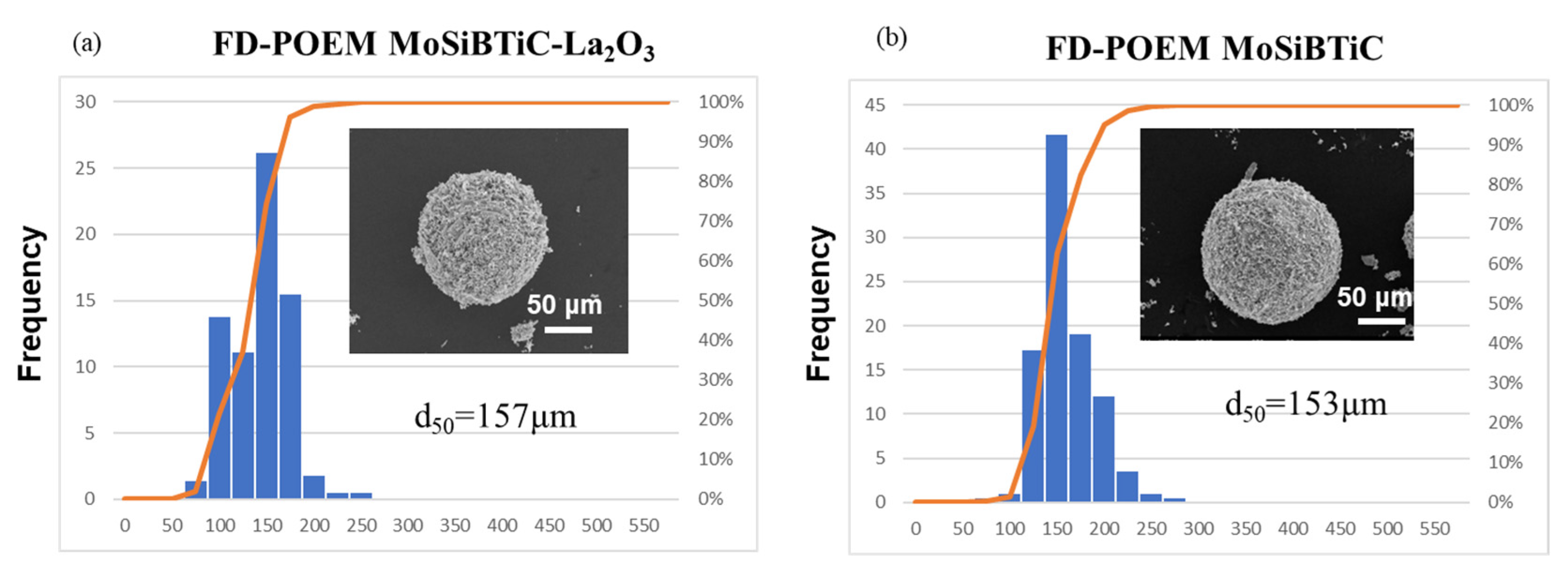
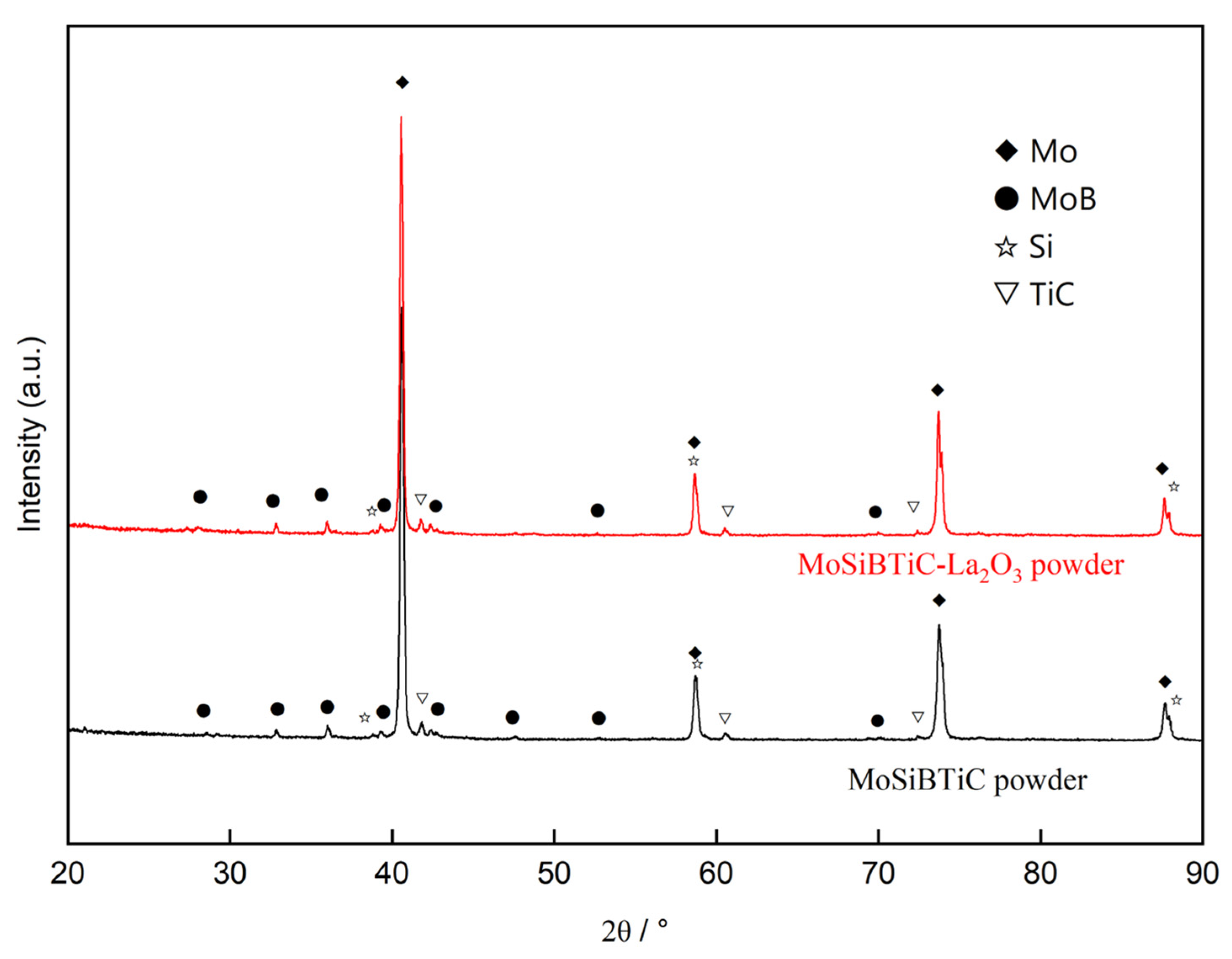
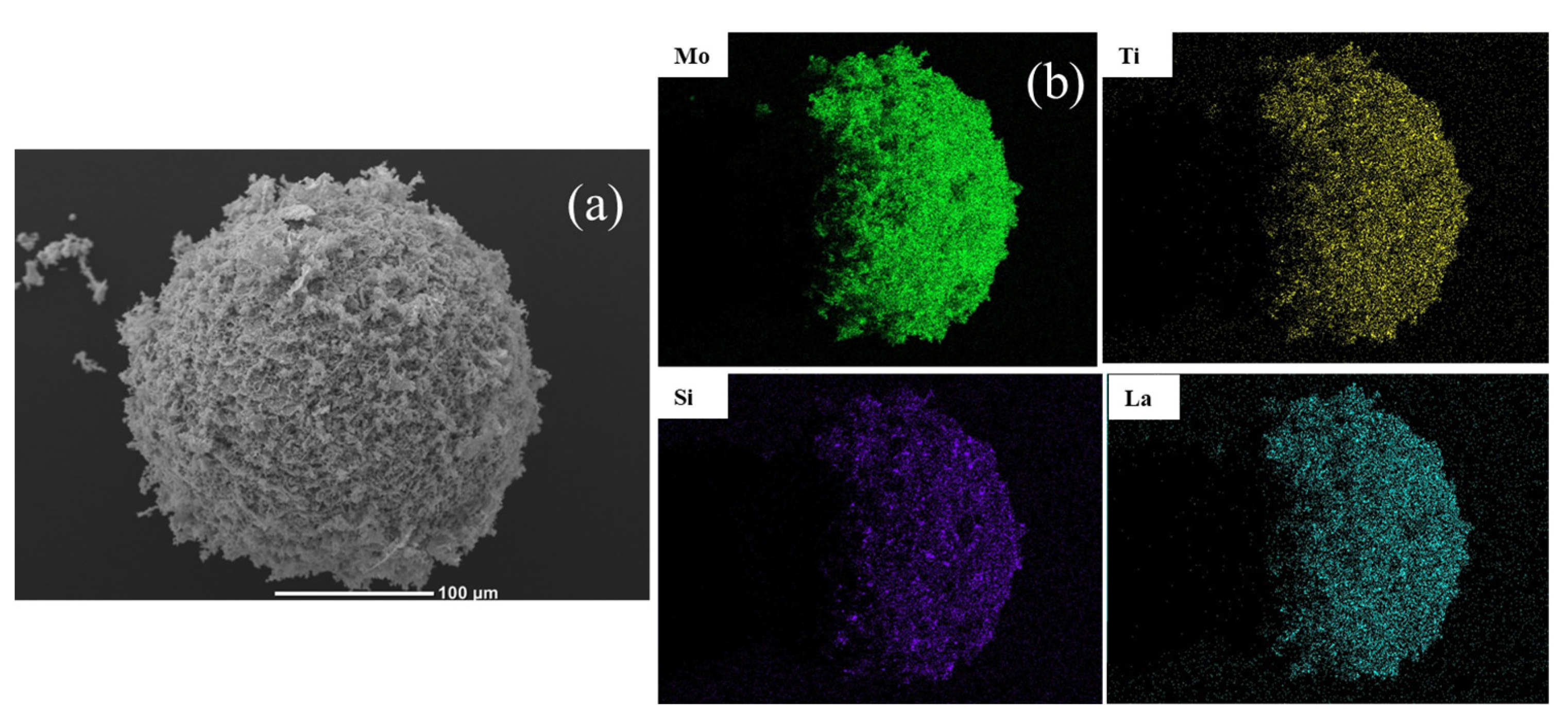
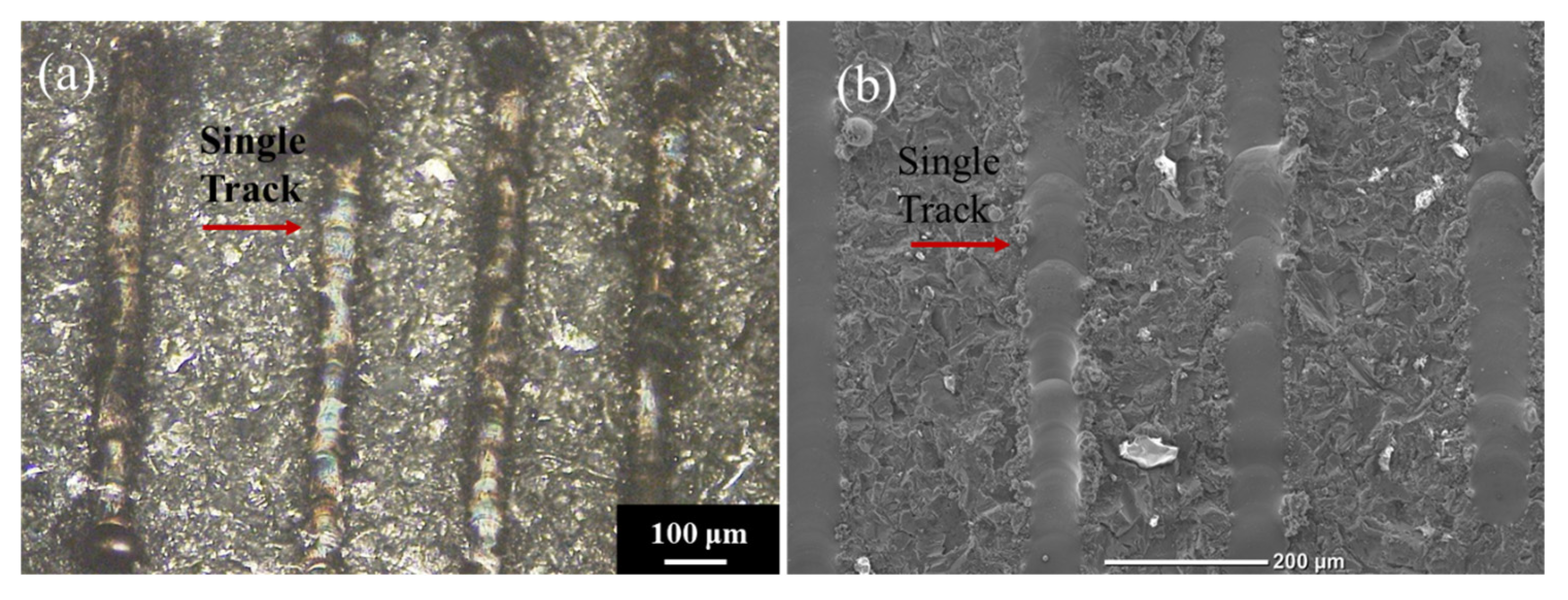
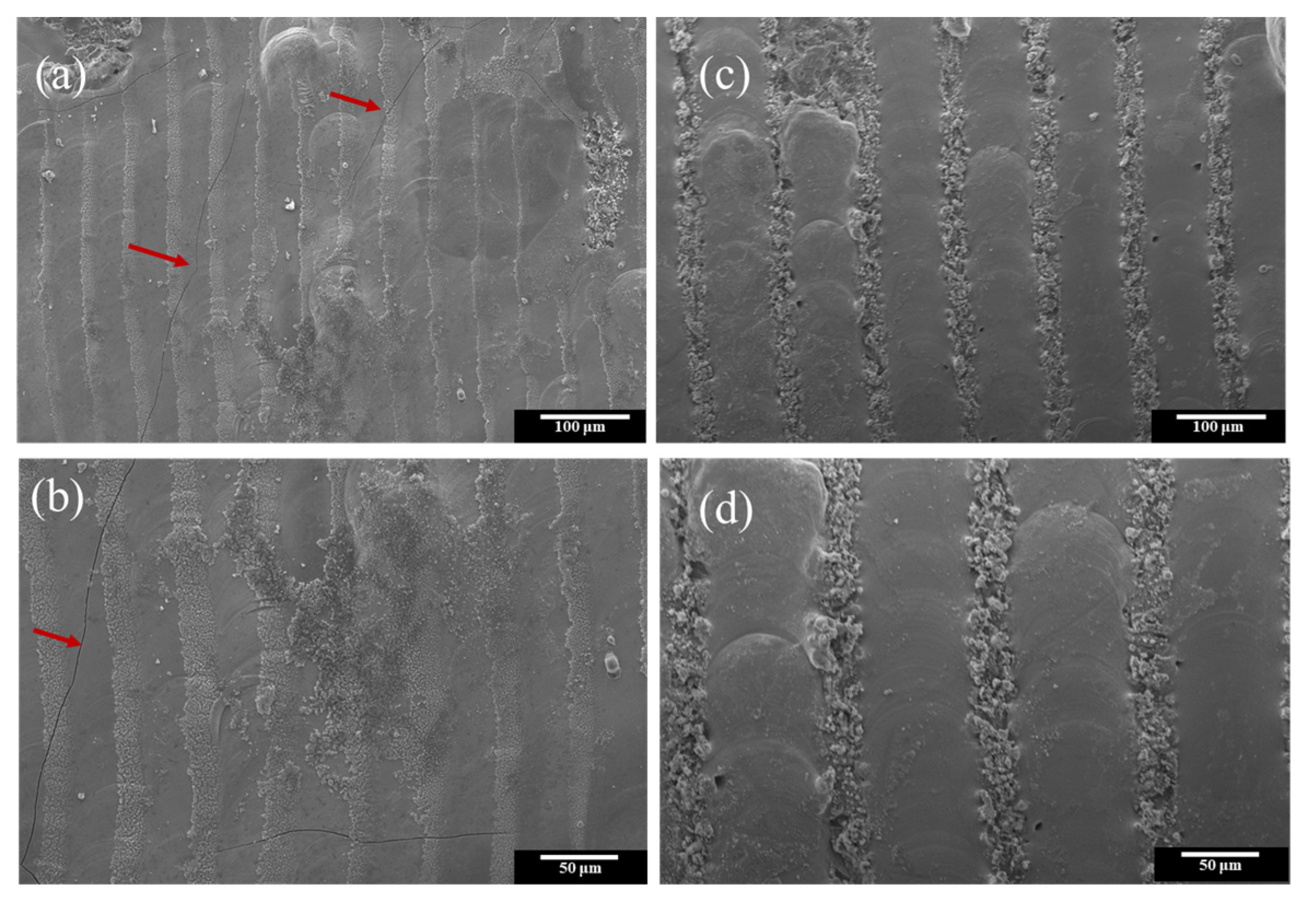



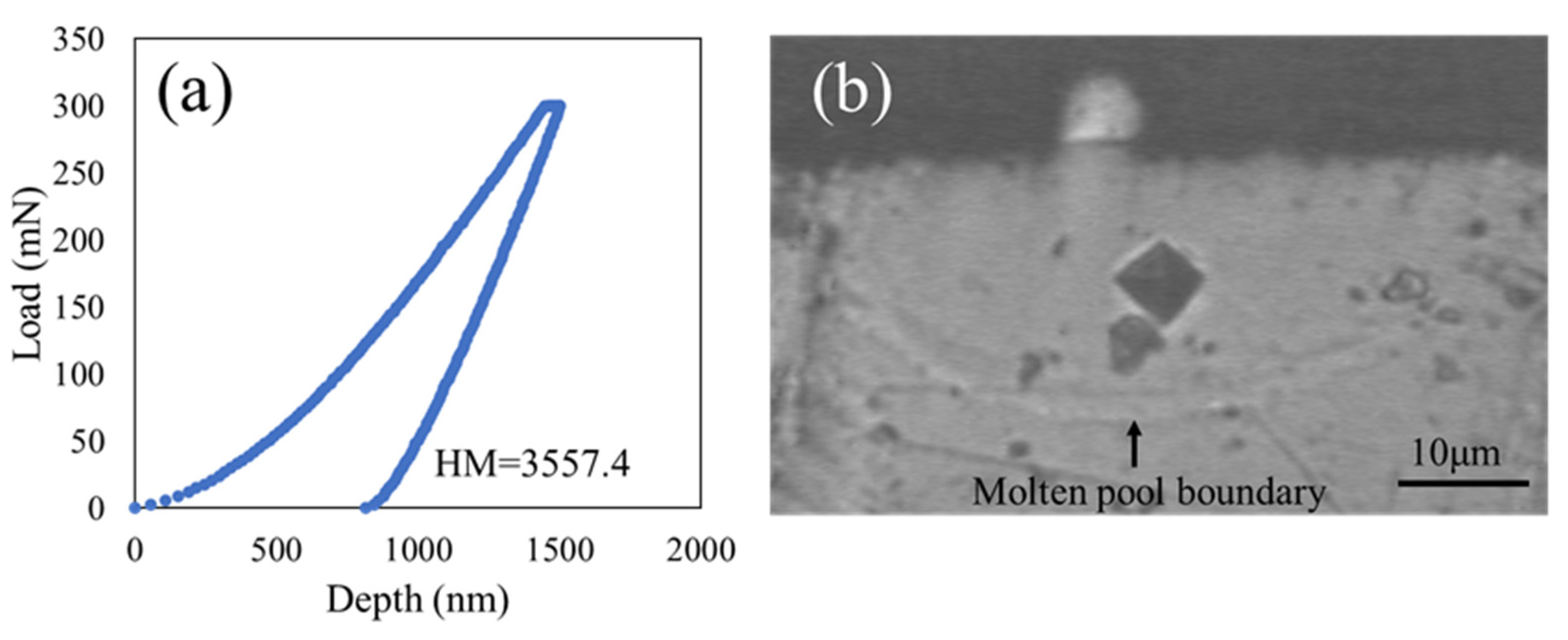
| L-PBF Parameters | Values |
|---|---|
| Laser power, P (W) | 20.6 |
| Scanning speed, ν (mm·s−1) | 10 |
| Hatch distance, h (μm) | 50,100 |
| Oxygen content | <0.5% |
Disclaimer/Publisher’s Note: The statements, opinions and data contained in all publications are solely those of the individual author(s) and contributor(s) and not of MDPI and/or the editor(s). MDPI and/or the editor(s) disclaim responsibility for any injury to people or property resulting from any ideas, methods, instructions or products referred to in the content. |
© 2023 by the authors. Licensee MDPI, Basel, Switzerland. This article is an open access article distributed under the terms and conditions of the Creative Commons Attribution (CC BY) license (https://creativecommons.org/licenses/by/4.0/).
Share and Cite
Li, C.; Guo, S.; Zhou, Z.; Zhou, W.; Nomura, N. Powder Fabrication and Laser Powder Bed Fusion of a MoSiBTiC-La2O3 Alloy. Crystals 2023, 13, 215. https://doi.org/10.3390/cryst13020215
Li C, Guo S, Zhou Z, Zhou W, Nomura N. Powder Fabrication and Laser Powder Bed Fusion of a MoSiBTiC-La2O3 Alloy. Crystals. 2023; 13(2):215. https://doi.org/10.3390/cryst13020215
Chicago/Turabian StyleLi, Chenguang, Suxia Guo, Zhenxing Zhou, Weiwei Zhou, and Naoyuki Nomura. 2023. "Powder Fabrication and Laser Powder Bed Fusion of a MoSiBTiC-La2O3 Alloy" Crystals 13, no. 2: 215. https://doi.org/10.3390/cryst13020215
APA StyleLi, C., Guo, S., Zhou, Z., Zhou, W., & Nomura, N. (2023). Powder Fabrication and Laser Powder Bed Fusion of a MoSiBTiC-La2O3 Alloy. Crystals, 13(2), 215. https://doi.org/10.3390/cryst13020215







